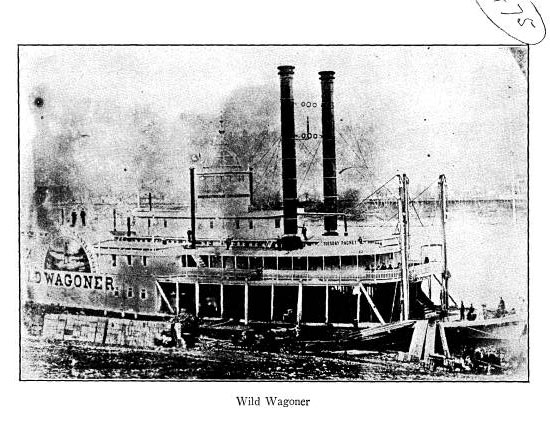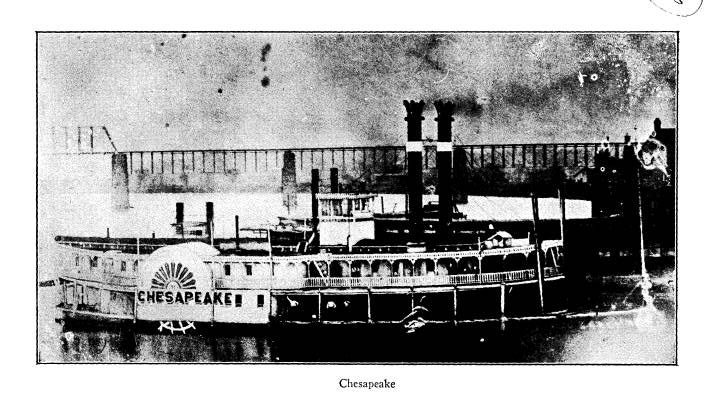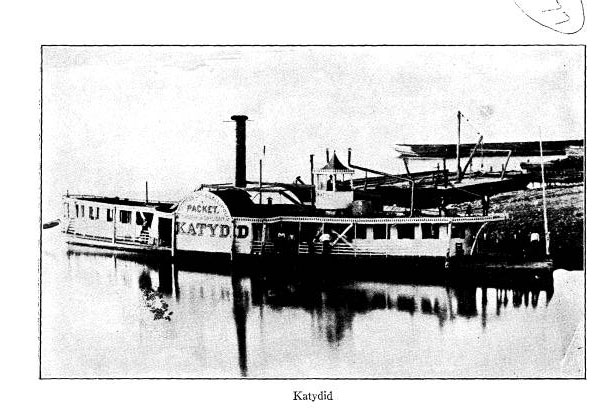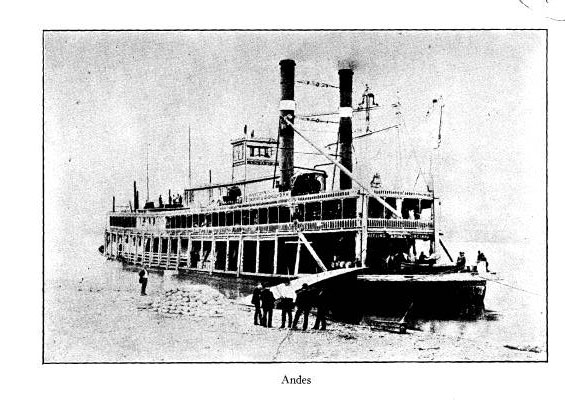Ohio History Journal
OLD OHIO RIVER STEAMBOAT DAYS
MEMORIES OF UPPER OHIO RIVER ACTIVITIES
BETWEEN
1860 AND 1890
BY W. G. SIBLEY
A great river is a powerful influence
over the lives
of all who dwell on its banks, just as
lofty hills or moun-
tains, seen day after day, finally come
to have meaning
in a man's life, as does any other
striking natural en-
vironment. When a river is intimately
associated with
the affairs of a small community, its
whole population
becomes conscious of it. So it was,
with boyhood in the
late 'sixties and 'seventies, when
spent in almost any vil-
lage along the Ohio River between
Pittsburgh and Cin-
cinnati, a never-to-be-forgotten
experience, for in those
decades the Ohio was "the stream
of the empire" when
the West was in the making.
The river and its activities, seen
season after season,
and year after year, get a strong grip
on a boy's imagi-
nation, desires and ambitions. It gave
me from 1865 to
1880 my first glimpse of the wide, wide
world--and its
unknown Far Away--to be explored in
later years. I
learned intimately its seasonal
changes, its high waters
and low waters, its near-by beaches,
bars and creeks, its
floating ice in winter, its fishing and
swimming in sum-
mer, its skating and johnboat adventures.
Every village
boy on the bank was acutely conscious
of the Ohio
River all the year around. It was so
with me from young
(86)
Old Ohio River Steamboat Days 87
boyhood to manhood in the village of
Racine, Ohio, mid-
way between Cincinnati and Pittsburgh
-- 460 miles
apart.
From spring to autumn in the late
'sixties the great
pine forests on the hillsides of the
Allegheny and Monon-
gehela Rivers floated down by the
village in huge rafts
of logs. In the 'seventies they were
replaced by rafts
of fragrant sawed lumber bound to ports
on the lower
Ohio and Mississippi. They were indelibly
etched on
memory. There was also the daily
panorama of tow-
boats pushing ahead of them acres of
heavily laden
barges of coal from Pittsburgh, or
great model barges
full of Pittsburgh and Wheeling
industrial products for
lower ports--a mighty volume of
commerce that con-
tinue to ride the river until the
country became a net-
work of railroads.
All these things were highly
interesting, but the finest
attraction of the river was the swift
passenger packets,
side-wheelers and stern-wheelers, half
a dozen or more
a day bound up or down-stream, full of
people, with
bands of music, and all painted white,
from their hulls
to their pilot-houses. The steamboat
era was in its hey-
day then, with no competition for quick
freight or pas-
senger transportation. The stage-coach
was passing
out and the railroads were only in
their beginnings. No-
where, not even on the Mississippi,
famous for its mag-
nificent passenger packets, did the
steamboats travel in
braver array, or mean more to the
populations along
the shores, than on the Upper Ohio. The
villages and
towns on the banks were the homes of
the crews--mas-
ters, pilots, engineers and
mates--whose standing was
|
88 Ohio Arch. and Hist. Society Publications |
Old Ohio River Steamboat Days 89
professional--and office clerks,
stewards, watchmen,
firemen, cabin boys, porters, maids and
deck-hands.
The first of these packets I recall was
the Wild Wag-
oner, whose name presumably was derived from the
poem of that title written by Thomas
Buchanan Read in
1862, in his many pages of "The
Wagoner of the Alle-
ghanies." This beautiful boat I
saw but once, about
1866, steaming up the river, the
fastest boat then afloat,
and a thrilling sight. The picture herewith
shown is
about seventy years old; and was taken,
when she was
tied up in port, before photography had
advanced to the
instantaneous process. The others
presented are more
than sixty years old, and also were
taken in port.
The Wild Wagoner was one of the
most famous
boats on the Ohio, remarkably
beautiful, and the last
word in luxury in her time. She was
brilliantly white
outside, with tall chimneys, a
side-wheeler whose wheel-
houses were elaborately decorated by
large paintings,
and a most artistic pilot-house crowned
by lofty ginger-
bread work. Her long, white, glittering
cabin had state-
rooms on both sides the full length of
the boat's upper
works. She had wide guards outside the
staterooms,
used for promenades by passengers, and
made safe by
fancy woodwork on the outer edges. She
was running
in the Wheeling and Cincinnati trade
when her picture
was taken.
The river valley population depended
almost wholly
on the river for both freight and
travel business. When
ice or low water suspended traffic
there were none but
dirt roads along the banks, often
impassable when winter
thaws came. The river traffic built the
towns from
Pittsburgh down--Wheeling, Marietta,
Parkersburg,
Old Ohio River Steamboat Days 91
Pomeroy, Gallipolis, Ironton,
Portsmouth and on to Cin-
cinnati. Much capital was invested in
them, and their
business was cut up into
"trades." There was the
through trade from Pittsburgh to
Cincinnati; the Wheel.
ing and Parkersburg trade; the Wheeling
and Cincin-
nati trade; the Parkersburg and
Gallipolis trade, and so
on down. Shorter trades existed between
Ravenswood
and Pomeroy; Gallipolis and Ironton;
and Ironton and
Cincinnati; with another prosperous
passenger, express
and freight trade between Pomeroy and
Cincinnati cared
for by three fine, large side-wheelers
that made tri-weekly
round trips, and competition was
lively.
Of these shorter trades, all regular
and well equipped
with handsome packets, that between
Parkersburg and
Gallipolis was served by a notably
popular side-wheel
packet that carried the mails for
twenty years or more,
the Chesapeake. She was a fine, swift boat with white
collars on her chimneys, as the picture
shows. Her
pilot-house sat on the roof of the main
cabin. Her
whistle was highly musical and carried
far. Packet
whistles generally could be heard and
recognized miles
before they came in sight. The Chesapeake
was extraor-
dinarily regular, running almost on a
railroad schedule.
In the early 'seventies a freak boat
was built for this
0trade, whose maiden trip aroused great
interest. She
was designed for speed as a daylight
packet; had neither
staterooms nor meal service, and was
called the Katydid.
She was a one-story packet, long and
very slim, utilizing
her hold for cabin purposes; but her
new-fangled en-
gines were a disappointment. She was
fast, but the vex-
atious delays because of her engine
troubles finally made
her unprofitable, and in a few years
she dropped out of
|
92 Ohio Arch. and Hist. Society Publications |
Old Ohio River Steamboat Days 93
the picture--an expensive experiment
never repeated.
In more than fifty years' knowledge of
Upper Ohio
steamboats, she was the only effort to
speed up a packet
above normal that I knew.
A very prosperous packet trade was that
between
Wheeling and Cincinnati, with boats
making one round
trip a week with time to discharge and
take on cargoes
at each terminus. Many large,
comfortable boats were
in it, among them the Edinburgh, the
Charmer, and the
Hudson, stern-wheelers, and for several years the St.
Lawrence, a fine side-wheeler.
But of them all the
Andes was the prime favorite in the 'seventies and
'eighties. She was commodious, regular,
kept up a fine
table, and never had a serious
accident. She possessed,
thanks to well-chosen officers and
other employes, that
intangible but highly valuable asset in
river travel of
that day, called
"atmosphere." She was homelike in a
period when Ohio River steamboat travel
was social.
Whether her passengers were fifty or a
hundred, her
crew had the knack of getting them
acquainted with each
other. Their wide acquaintance along
shore enabled
them to form congenial groups--business
men going to
Cincinnati to buy stocks for their
stores; their wives
who were on board just for a trip; and
the young people
to whom it was an event to see 400
miles of the Ohio.
There was sociability among travelers
in river times,
with much sightseeing, dancing at
night, and card-
playing by day.
Friendships were made and cemented,
business views
exchanged, and travel thereby made
delightful. The
Andes had a soft, melodious whistle that did not disturb
rest, and a little bar in the men's
cabin where the thirsty
|
94 Ohio Arch. and Hist. Society Publications |
Old Ohio River Steamboat Days 95
could find good liquors. The boat was
famous for honey-
mooners when the river was the
pleasantest outlet for
the newly-married, and Cincinnati the
one large city
easily reached, with her celebrated May
musical festi-
vals that drew thousands of
music-lovers for 400 miles
up and down the river. The great
hilltop German beer-
gardens with their music and gaiety
justified the proud
claim of Murat Halstead, her most
versatile editor, that
the Queen City was "the Paris of America."
The Andes,
with her long, broad, snow-white cabin
and her glass
chandeliers which tinkled when she
vibrated under way,
made travel both comfortable and
agreeable. She gave
her passengers time to see the historic
attractions of
Marietta; the old French "City of
the Gauls," Gallipolis;
Blennerhassett Island, and the imposing
hills and frown-
ing cliffs of Pomeroy, "seven
miles long and as far back
as you could see," which is to her
cliffs, with her two
long streets between them and the
River.
The "White Collar Line,"
plying between Pomeroy
and Cincinnati, had three boats in
operation all the time,
among them being the large
side-wheelers Telegraph,
Bonanza, Big Sandy, Bostona and Ohio No. 4.
Other boats in the trades were the Major
Anderson,
Keystone State, Scotia, St. Charles,
and smaller packets
like the Mattie Roberts and Emma
Graham, to which
should be added a boat called the Humming
Bird, run-
ning between the Pomeroy Bend and
Gallipolis, and
profitably operated for many years.
Like the Katydid
she carried only passengers, and was
the only boat of
the "propeller" type I ever
saw on the Ohio. Her hull
was her cabin. She was swift, regular
and successful.
96 Ohio Arch. and Hist. Society Publications
Mark Twain gave the Mississippi River a
place in
literature with his Life on the
Mississippi, relating his
experiences as a pilot. It was a boy's
classic in my
youth, that applied to the Ohio as
well. Indeed, the
American humorist might have found the
Ohio River
richer in river lore and legend and
adventure than the
Mississippi, had his lot been cast in
the Ohio Valley.
Archer Butler Hulbert put the Ohio in
literature in his
The Stream of Empire, which is essentially historic. In
any event the literature of the Ohio is
scanty when one
considers the prodigious volume of
freight and passenger
traffic it bore between 1860 and 1890,
the heyday of
steamboating on the Upper Ohio. In the
'nineties the
great decline set in which brought to
an end the romance
of the steamboat on western rivers. The
railroads have
all but crowded out the passenger
packets, the last of the
very large boats having been the famous
side-wheeler
Kate Adams.
Little is left now but memories, and
they are fast
disappearing as the old professional
river men, captains,
pilots and engineers, drop off. Time
was when every
steamboat I have mentioned brought a
thrill. But none
do that now. The canalization of the
Ohio from source
to mouth ended the former glories of
river life. Travel
on the River is prosaic now.
From the close of the Civil War, when
thousands of
soldiers found their way home to Ohio,
West Virginia,
Kentucky, Indiana and Illinois on the
boats, on through
the thirty years from 1860, Ohio River
traffic, both
freight and passenger, was important
and exerted a
powerful influence on social and
economic progress along
|
Old Ohio River Steamboat Days 97 the shores. It has all largely passed away now, in all probability never to return, and with its passing have gone many of the delights of travel. |
|
|
|
Vol. XLI-7. |




